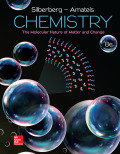
Concept explainers
(a)
Interpretation:
Concept introduction:
Titration:
Titration is a quantitative chemical analysis to determine the concentration of an identified analyte. The titrant is the reagent which is prepared as a standard solution of known concentration volume. The titrant reacts with the analyte to determine the analyte’s concentration. The volume of the titrant reacting with analyte is called the titration volume.
Equivalence point:
Equivalence point in the titration reaction is the point where the amount of titrant added is absolutely enough to neutralize completely the analyte. The moles of titrant and the moles of analyte are same at this point.
pH:
(a)
Answer to Problem 19.138P
Explanation of Solution
HF being a weak acid dissociates slowly in the solution producing less number of
Let the dissociation constant be x.
Given that initially the concentration of HF is
Now, substituting the values,
(
Hence, concentration of
Thus
Hence
(b)
Interpretation:
Amount of titrant (
Concept introduction:
Titration:
Titration is a quantitative chemical analysis to determine the concentration of an identified analyte. The titrant is the reagent which is prepared as a standard solution of known concentration volume. The titrant reacts with the analyte to determine the analyte’s concentration. The volume of the titrant reacting with analyte is called the titration volume.
Equivalence point:
Equivalence point in the titration reaction is the point where the amount of titrant added is absolutely enough to neutralize completely the analyte. The moles of titrant and the moles of analyte are same at this point.
pH:
(b)
Answer to Problem 19.138P
The amount of titrant required to achieve equivalence point is
Explanation of Solution
Volume of
Strength of
Strength of
According to volumetric titration,
Therefore,
Hence, the amount of titrant required to achieve equivalence point is
(c)
Interpretation:
The value of
Concept introduction:
Titration:
Titration is a quantitative chemical analysis to determine the concentration of an identified analyte. The titrant is the reagent which is prepared as a standard solution of known concentration volume. The titrant reacts with the analyte to determine the analyte’s concentration. The volume of the titrant reacting with analyte is called the titration volume.
Equivalence point:
Equivalence point in the titration reaction is the point where the amount of titrant added is absolutely enough to neutralize completely the analyte. The moles of titrant and the moles of analyte are same at this point.
pH:
(c)
Answer to Problem 19.138P
Explanation of Solution
Given that
Now according to question
Number of moles of
Hence number of moles of
Thus the concentration of
Thus the concentration of
Hence,
From Henderson-Hasselbalch equation,
Hence,
Hence,
(d)
Interpretation:
Concept introduction:
Titration:
Titration is a quantitative chemical analysis to determine the concentration of an identified analyte. The titrant is the reagent which is prepared as a standard solution of known concentration volume. The titrant reacts with the analyte to determine the analyte’s concentration. The volume of the titrant reacting with analyte is called the titration volume.
Equivalence point:
Equivalence point in the titration reaction is the point where the amount of titrant added is absolutely enough to neutralize completely the analyte. The moles of titrant and the moles of analyte are same at this point.
pH:
(d)
Answer to Problem 19.138P
Explanation of Solution
At equivalence point we are considering the equation:
At equivalence point the number of moles of
Now,
Thus the acid dissociation constant of the base can be calculated as,
Say concentration of
Thus the concentration of
At
Hence, concentration of
Thus
Hence
(e)
Interpretation:
Value of
Concept introduction:
Titration:
Titration is a quantitative chemical analysis to determine the concentration of an identified analyte. The titrant is the reagent which is prepared as a standard solution of known concentration volume. The titrant reacts with the analyte to determine the analyte’s concentration. The volume of the titrant reacting with analyte is called the titration volume.
Equivalence point:
Equivalence point in the titration reaction is the point where the amount of titrant added is absolutely enough to neutralize completely the analyte. The moles of titrant and the moles of analyte are same at this point.
pH:
(e)
Answer to Problem 19.138P
The value of
Explanation of Solution
After equivalence point there will be excess
Thus concentration of
At
Hence, concentration of
Thus
The value of
Want to see more full solutions like this?
Chapter 19 Solutions
EBK CHEMISTRY: THE MOLECULAR NATURE OF
 ChemistryChemistryISBN:9781305957404Author:Steven S. Zumdahl, Susan A. Zumdahl, Donald J. DeCostePublisher:Cengage Learning
ChemistryChemistryISBN:9781305957404Author:Steven S. Zumdahl, Susan A. Zumdahl, Donald J. DeCostePublisher:Cengage Learning ChemistryChemistryISBN:9781259911156Author:Raymond Chang Dr., Jason Overby ProfessorPublisher:McGraw-Hill Education
ChemistryChemistryISBN:9781259911156Author:Raymond Chang Dr., Jason Overby ProfessorPublisher:McGraw-Hill Education Principles of Instrumental AnalysisChemistryISBN:9781305577213Author:Douglas A. Skoog, F. James Holler, Stanley R. CrouchPublisher:Cengage Learning
Principles of Instrumental AnalysisChemistryISBN:9781305577213Author:Douglas A. Skoog, F. James Holler, Stanley R. CrouchPublisher:Cengage Learning Organic ChemistryChemistryISBN:9780078021558Author:Janice Gorzynski Smith Dr.Publisher:McGraw-Hill Education
Organic ChemistryChemistryISBN:9780078021558Author:Janice Gorzynski Smith Dr.Publisher:McGraw-Hill Education Chemistry: Principles and ReactionsChemistryISBN:9781305079373Author:William L. Masterton, Cecile N. HurleyPublisher:Cengage Learning
Chemistry: Principles and ReactionsChemistryISBN:9781305079373Author:William L. Masterton, Cecile N. HurleyPublisher:Cengage Learning Elementary Principles of Chemical Processes, Bind...ChemistryISBN:9781118431221Author:Richard M. Felder, Ronald W. Rousseau, Lisa G. BullardPublisher:WILEY
Elementary Principles of Chemical Processes, Bind...ChemistryISBN:9781118431221Author:Richard M. Felder, Ronald W. Rousseau, Lisa G. BullardPublisher:WILEY





